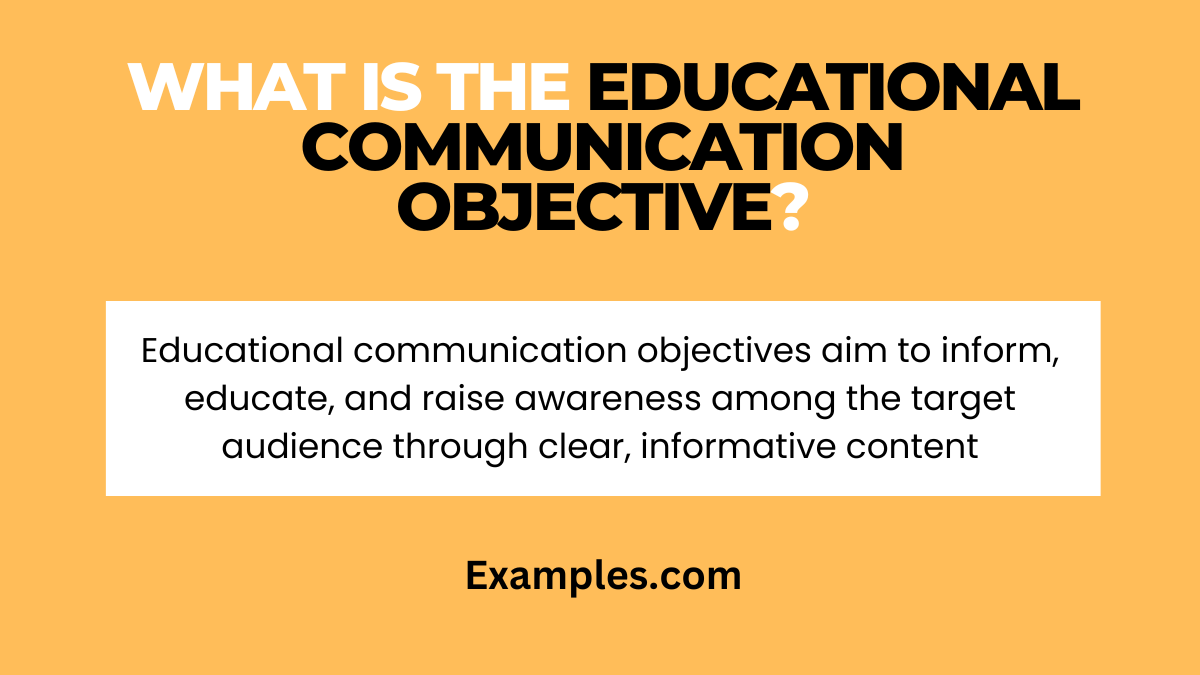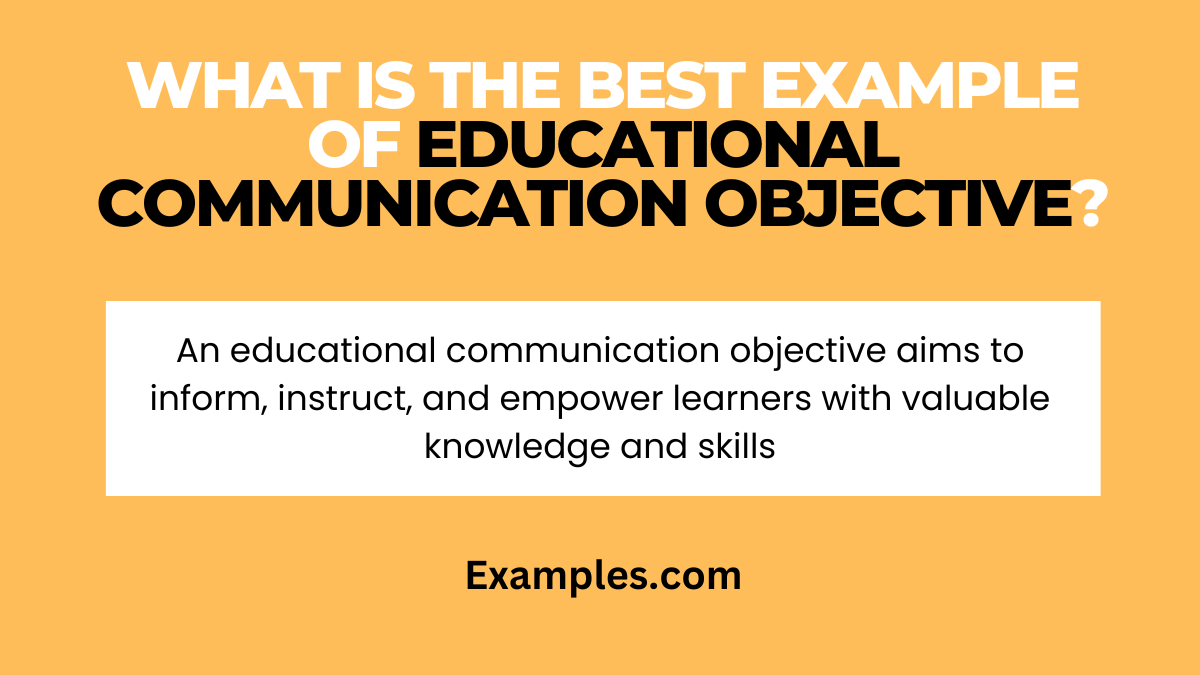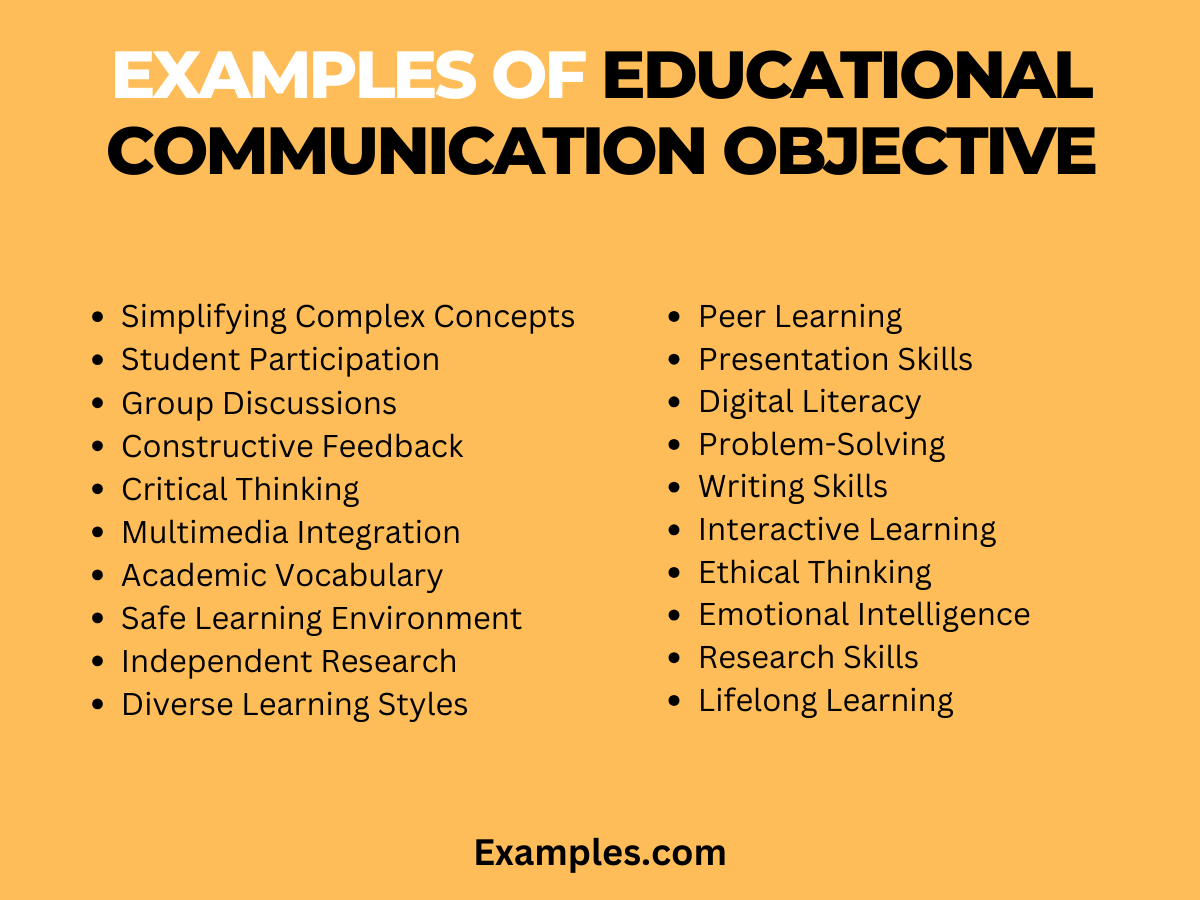19+ Educational Communication Objective Examples
Educational Communication Objective serves as a cornerstone in educational settings, aiming to enhance learning experiences and outcomes. It involves strategically crafting messages to effectively transmit knowledge, stimulate engagement, and foster an interactive learning environment. This guide delves into the nuances of setting clear objectives, utilizing diverse communication methods, and offers actionable tips to optimize educational outcomes. Emphasizing on the vital role of clarity and purpose, it presents Educational Communication Objective as an indispensable tool in the realm of education.
What is the Educational Communication Objective?

The Educational Communication Objective is a pivotal goal in the educational process, focusing on the clear and effective transmission of knowledge and information. It encompasses various techniques and strategies designed to engage students, promote understanding, and facilitate a productive educational environment. This objective is crucial in shaping the overall learning experience and ensuring that educational messages are delivered effectively and efficiently.
What is the Best Example of Educational Communication Objective?

A prime example of an Educational Communication Objective is the use of interactive digital platforms to explain complex scientific concepts. By employing visual aids, interactive simulations, and real-time feedback, educators can enhance students’ understanding and retention of the subject matter. This approach not only makes learning more engaging but also ensures that the educational content is accessible and comprehensible to all students.
20 Examples of Educational Communication Objective

Educational communication objectives focus on enhancing learning, understanding, and engagement through effective information exchange. They aim to clarify concepts, encourage critical thinking, and facilitate a conducive learning environment. In educational settings, clear communication objectives are pivotal in achieving successful teaching outcomes and fostering an inclusive and interactive educational experience.
- Clarifying Complex Concepts: Simplifying challenging topics for better student comprehension.
Example: “Let’s break down this complex theory into more manageable parts.” - Encouraging Student Participation: Creating an environment where students feel comfortable sharing their ideas.
Example: “I encourage everyone to contribute their thoughts on this topic.” - Facilitating Group Discussions: Guiding students in collaborative learning activities.
Example: “Let’s form groups and discuss different perspectives on this subject.” - Providing Constructive Feedback: Offering positive and improvement-focused feedback.
Example: “Your essay was well-written, but let’s work on developing your thesis further.” - Promoting Critical Thinking: Encouraging students to analyze and question information.
Example: “What are the potential implications of this theory in real-world scenarios?” - Integrating Multimedia Tools: Using technology to enhance learning experiences.
Example: “We’ll use this interactive software to explore this concept further.” - Building Academic Vocabulary: Helping students develop subject-specific language skills.
Example: “Today, we’ll focus on key terms in molecular biology.” - Fostering a Safe Learning Environment: Ensuring all students feel secure and valued.
Example: “Our classroom is a space where every opinion is respected.” - Encouraging Independent Research: Motivating students to explore topics on their own.
Example: “I challenge you to find additional sources on this topic for our next class.” - Supporting Diverse Learning Styles: Adapting teaching methods to accommodate different learners. Example: “I’ll provide both visual aids and written summaries for this lesson.”
- Facilitating Peer Learning: Encouraging students to learn from each other.
Example: “Partner up and share your insights on this chapter.” - Enhancing Presentation Skills: Teaching students effective ways to present information.
Example: “Focus on clear articulation and engaging visuals for your presentation.” - Promoting Digital Literacy: Integrating digital skills into learning processes.
Example: “We’ll use online resources to deepen our understanding of this subject.” - Cultivating Problem-Solving Skills: Encouraging students to tackle complex problems.
Example: “Let’s brainstorm potential solutions for this case study.” - Developing Writing Skills: Guiding students in refining their writing abilities.
Example: “We’ll work on structuring your arguments more coherently in your essays.” - Implementing Interactive Learning: Engaging students through interactive teaching techniques. Example: “This game will help us explore the concept in a fun, interactive way.”
- Encouraging Ethical Thinking: Teaching students to consider the ethical aspects of topics.
Example: “Let’s discuss the ethical implications of this scientific development.” - Facilitating Emotional Intelligence: Helping students understand and manage emotions.
Example: “This exercise will aid in recognizing and articulating our emotions better.” - Building Research Skills: Guiding students in effective research methodologies.
Example: “Today, we’ll learn how to properly cite sources in our research.” - Encouraging Lifelong Learning: Instilling a love for continuous learning.
Example: “Remember, learning doesn’t end in the classroom. Keep exploring!”
What are the Educational Objectives of Communication Skills for Teachers?
- Enhancing Clarity and Conciseness: Aiming to communicate complex ideas in a clear, concise manner that is easily understandable to students.
- Promoting Active Listening: Developing skills to listen actively and empathetically to students, fostering a more interactive learning environment.
- Improving Feedback Delivery: Mastering the art of giving constructive, positive feedback that encourages student growth and learning.
- Cultivating Emotional Intelligence: Harnessing emotional intelligence to understand and respond to students’ needs and emotions effectively.
- Facilitating Collaborative Learning: Encouraging group discussions and collaborative learning experiences through effective communication strategies.
- Adapting to Diverse Audiences: Tailoring communication styles to suit the diverse learning needs and backgrounds of students.
How Do You Write a Good Educational Communication Objective?
- Be Specific and Clear: Clearly define what you want to achieve with your communication in terms of student learning outcomes.
- Make it Measurable: Set objectives that can be assessed and measured to track progress and effectiveness.
- Ensure Relevance: Align communication objectives with overall educational goals and student needs.
- Be Realistic: Set achievable and practical objectives considering the resources and time available.
- Focus on Engagement: Aim to create objectives that foster student engagement and participation.
- Incorporate Feedback Mechanisms: Include ways to receive and integrate feedback from students to continuously improve communication effectiveness.
Goals for Educational Communication Objective
- Strengthening Understanding: Ensuring students grasp course material thoroughly through clear and effective communication.
- Enhancing Student Participation: Encouraging more active participation from students in classroom discussions and activities.
- Building Critical Thinking Skills: Using communication to challenge students and develop their critical thinking and problem-solving skills.
- Supporting Individual Learning Paths: Recognizing and accommodating varied learning styles and needs through adaptive communication.
- Promoting Self-Expression: Encouraging students to express their thoughts and opinions confidently.
- Fostering a Positive Learning Environment: Creating a supportive and inclusive atmosphere through respectful and empathetic communication.
Educational Communication Objective for Students
- Developing Effective Communication Skills: Building strong verbal and non-verbal communication abilities for academic and personal success.
- Enhancing Group Interaction: Learning to effectively communicate in group settings for collaborative projects and discussions.
- Improving Presentation Skills: Gaining confidence and proficiency in public speaking and presentations.
- Cultivating Active Listening Abilities: Focusing on listening actively and critically to understand and engage with academic content.
- Encouraging Constructive Peer Feedback: Developing skills to provide and receive constructive feedback among peers.
- Adapting Communication for Various Contexts: Learning to adjust communication styles for different situations and audiences within the educational setting.
Effective educational communication objectives serve as a beacon of knowledge, illuminating the path of learning. Crafting content that informs, instructs, and empowers is the cornerstone of educational success. By following these guide and tips, you can inspire a thirst for knowledge and foster meaningful learning experiences.



